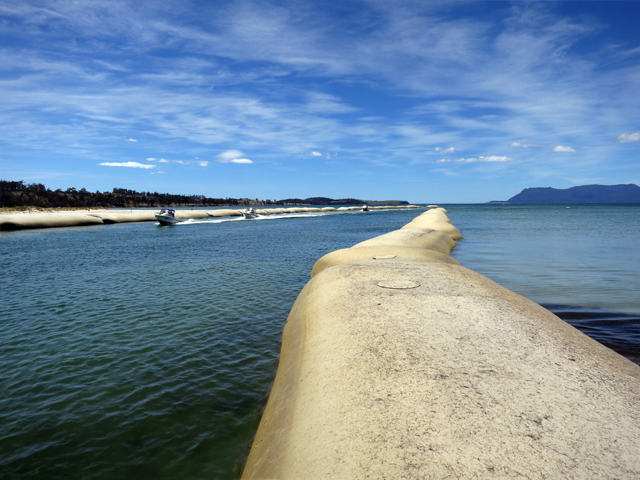Bending nature to our will is not a straightforward matter.

Pleasure craft using the newly-made channel through Prosser’s sands.
The little beach near Port Arthur where my family used to camp over summer was the perfect place for a boy to play out fantasies about coastal engineering.
As with so many beaches around Tasmania, at one end of Stewarts Bay there’s a little lagoon with a creek, which with enough flow finds its way over the sand to the sea.
I think I found nature all too irregular, because I used to like damming the creek with the camping spade, then diverting the overflow along a channel down to the waves. Every high tide washed out my handiwork, but it didn’t stop me doing it all again, and again.
We sometimes travelled up the east coast to Orford, which offered a similar scenario. Except that the Prosser is a river and messing about with a spade isn’t going to change its course. Instead we dug great holes in the beach, because you could.
There’s a lot of sand at the head of Prosser Bay, which makes for big landform changes as a stormy sea does its handiwork, or a river in flood – a wonderful place for children, or anyone, to explore.
Others haven’t seen things quite that way. Chris Dillon, boat-owner and member of the Orford-Triabunna Chamber of Commerce, has been campaigning for years for a permanent channel to allow boats to pass freely from the Prosser estuary to the sea.
I see what he’s getting at. Orford could be a pleasure-boat paradise. Its lagoon is perfect for tying up, and Maria Island stops big ocean swells in Prosser Bay. But there’s that damn sandbar.
Various dredging operations in the past came to nought as the beach quickly reverted to its natural form, so the boat-owners called for something more serious.
Enter Glamorgan-Spring Bay mayor Michael Kent, who committed $250,000 in council funds, and infrastructure minister Rene Hidding, who found the remaining three-quarters of a $1.04 million estimate for making a channel through the sand to the sea.
Last April Tasmanian-based engineers Burbury Consulting were contracted to do pretty much what I used to do, except on a grander scale. And unlike my constructions, doomed to be obliterated with the next high tide, this one is intended to last 30 years.
The key to this bit of geoengineering is a “geotextile revetment” on either side of the channel, whereby bags made from a woven synthetic fabric are filled with sand and stacked to form a sloping wall to hold back the beach sand.
Since April Burbury Consulting have cut through the sandbar and put the removed sand into huge bags (each filled bag weighs around 200 tonnes) which they’ve stacked along either side of the river mouth to create a “permanent” channel.
One of the project’s complications was pressure from Birdlife Tasmania to protect shore bird habitat. The planned course of the channel has been shifted to allow more sandy area for birds to breed and forage, and this may have created some issues with the outflow through the channel.
Beach users have had the odd surprise. Debbie Wisby, a Glamorgan Spring Bay councillor, reported a person walking near the edge of the channel who suddenly dropped chest-deep into the sand, apparently a result of erosion behind the walls.
A few of the bags have been found to be torn, perhaps a manufacturing defect, resulting in sand being washed out, and there’s been criticism of irregularities in the way they were laid.
Engineering know-how and modern technology should find solutions to such problems. But redesigning sandy coasts is a very uncertain business, and greater certainty comes at a greater price. We may not have seen the last powerboat stranding on a Prosser River sandbar.
The paperwork shows that authorities considered opposing points of view in the approval process, including objections over bird breeding and other nature conservation issues, but judged they were not sufficient to stop the project going ahead.
The instigators of these sorts of infrastructure cases, the ones pushing hardest, tend to get most of the attention as “principal stakeholders”. In the Prosser case they’re marine administrators and owners of boats and waterfront property. The pressure they exert is hard to resist.
I’m just an occasional visitor with happy childhood memories of Orford’s beaches. I could never claim to be a major stakeholder, and I appreciate this project is now effectively done and dusted. But it doesn’t hurt to remind people that in cases like this doing nothing is a real option.
Had the channel not been built, crossing the sandbar would have remained a risk for boat-owners, but they always had the option of using the open-water port of Triabunna, a 15-minute drive away.
Without the channel the many beach users who treasured this spot could have continued to enjoy the natural pleasures of a meandering watercourse across an endlessly-changing beachscape, free of contrived coastlines and seawalls.
Sometimes, progress is just an illusion.
